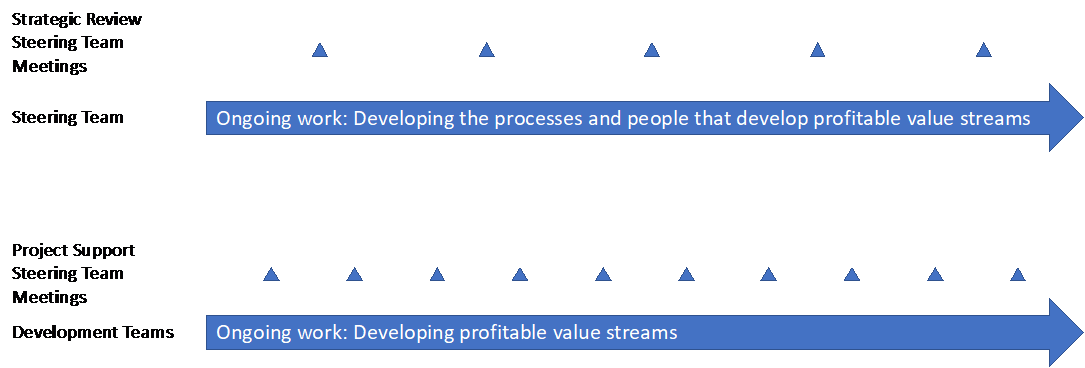After years of working closely with our Lean Product and Process Development Learning Group and its Learning Partner organizations, we’ve found that a well-functioning steering team is essential for making meaningful progress in applying lean principles to product development. The following summarizes our observations and findings since 2015 in four key areas that the team must address:
- Setting the steering team’s purpose
- Involving key people
- Adhering to a meeting process
- Using best practices for starting and sustaining an effective steering team
Although focused on support of an LPPD initiative – this same thinking applies in managing and supporting any initiative. It is only a matter of swapping out the term “LPPD” and changing a few nouns.
Organizations with active and engaged steering teams see improvements expand throughout their enterprises, enjoying high quality, better delivery, and reduced lead times for their development processes.Purpose
A steering team defines, guides, and supports the lean product and process development (LPPD) activities. The team:
- Understands and articulates how LPPD fits into the organization’s strategic vision. Stephen Covey once said, “Priority is a function of context.” If LPPD is to be a real priority in your organization, it needs a context.
- Communicates and refines LPPD’s role, preferably by a strategic A3. In a March 2015 Harvard Business Review article, “Why Strategy Execution Unravels – and What to do about it,” the authors cite Myth #1 (of 5) as “Execution Equals Alignment.” Even if everyone is saying they are supporting your LPPD initiative, are they acting in an aligned way? Does LPPD even have a common definition throughout the organization? The steering team can relentlessly communicate the LPPD strategy while refining it. And there is no better process than the A3 to capture the steering team’s thinking, refine their message and share it with others.
- Agrees on and sponsors projects to gain experience and spread LPPD throughout the enterprise. Learning lean in the production world often starts with a pilot or model line. It is the focused area selected by the organization to apply lean tools, processes, and management – and learn from. This model line is often the seed from which lean spreads throughout manufacturing. In LPPD a similar model is needed – an actual product development; one that starts with an early idea and eventually launches into profitable production. A pilot like this must be commissioned. LPPD won’t happen due to a grass-roots effort. The steering team, in support of LPPD and its strategic vision, needs to deliberately commission the right projects from which to learn.
- Ensures projects are properly resourced. This is a moving target. All teams will think they need more resources, all managers will think the teams are fine the way they are or could actually do with fewer resources. The important thing is to have an ongoing discussion.
- Is available to the project teams on a regular cadence, removing roadblocks and providing technical support. My sensei, Yamada-san, used to say, “The same substance can be medicine or poison, it just depends on how you use it.” This came up in a discussion about andon. If a project team signals for help, then the steering team needs to provide help. Poison is when a signal is sent and there is no response, or the response actually feels like more work.
- Participates in an ongoing plan, do, check, adjust (PDCA) cycle relative to the pilot projects and the overall LPPD initiative as well. This point ties the previous 5 points together. No one starts an LPPD journey with perfect knowledge, and even if you did, things change. So ongoing PDCA is a must.
- Ensures the organization captures and shares what it is learning. To grow LPPD, lessons learned need to be captured and shared.
People
Who should be involved in the steering team? Start with the executive sponsor(s) who will lead and support the project teams. Do not over staff the steering team upfront. The tendency is to have a representative from every function because it seems “fair.” Although this may be an ideal future state, it is best to grow the steering team organically. To misquote Einstein, “as small as possible, but no smaller.” Add new members based on need, then their role on the team will be clear and they will be less likely to sit in the back and play solitaire during steering meetings. There is also a critical role for an outside advisor, or senior advisor, who is deeply experienced in this type of transformation and can challenge the organization’s leadership and provide technical guidance as well.
An example of this organic growth model for the team may look like:
- Starting with the leads of product development, process development, operations, and the senior advisor
- Adding the lead for marketing after hitting a roadblock requiring marketing’s involvement
- Adding the leads for purchasing and finance when issues with suppliers and project approvals arise
- And so on
Of course, your steering team’s growth will take on its own unique path. The key is to start and then grow based on need.
“An effective operating system moves an organization toward its objectives in order to accomplish its mission. It creates a cadence or regularly occurring management activities instead of episodic management interventions.” – Jim Morgan
Process
A successful steering team has meetings at a regular cadence, at the right frequency, for the appropriate duration. We suggest differentiating two types of meetings:
- LPPD strategic A3 reviews, which focus on the steering team’s progress and are attended by all the core steering team members. Since the strategic transformation of an organization is long-cycle work, these meetings may occur less frequently. Or they may not.
- LPPD project support meetings, which focus on resolving any issues escalated by the project teams. These are attended by project team members and depending on the type of problem escalated, designated steering team members. For example, cost issues might escalate to a meeting co-chaired by the product and purchasing leads on the steering team.

Regardless of the frequency and duration selected, the cadence needs to be preserved. In the words of LPPD Senior Advisor Jim Morgan, who writes in his new book Designing the Future, “An effective operating system moves an organization toward its objectives in order to accomplish its mission. It creates a cadence or regularly occurring management activities instead of episodic management interventions.” Start canceling meetings and you are on the slippery slope to “episodic management.”
Best Practices
“Human beings, who are almost unique in having the ability to learn from the experience of others, are also remarkable for the apparent disinclination to do so.” – Last Chance to See by author Douglas Adams.
Although not an all-inclusive list, here are steering team best practices that we have observed:
- Leverage the gemba whenever possible. Move the meetings from a conference room to your product development area, process mock-up space, or shop floor. This can be the obeya from which the project is being run. Or you may choose to have a gemba walk prior to the meeting, creating a context for all those participating. Provide the team with constructive feedback based on what is seen at the gemba.
- Keeping the schedule. As mentioned earlier, the cadence of steering team meetings can provide a heartbeat to progress. When the organization knows that the meeting will happen, they will prepare accordingly. Never cancel a steering meeting due to lack of progress, that just starts a downward spiral toward even less progress. Hold the meeting. PDCA the process. Provide help. An unexpected benefit of making the cadence sacred is reduced email traffic. Yes, you read that correctly. If another meeting is just around the corner, and an issue can wait without being detrimental to the project, people will learn to just rely on the next meeting.
- Use A3s. They keep the discussions focused and with a few hand-written annotations, can become the meeting minutes. To be effective, A3s must be used and updated between meetings.
- Start small and grow organically. Who are the critical few that need to be on the steering team? Start there. It is typically those who control the resources of the project team. But as the pilot grows, so will the team members.
- Bring a friend, but keep the meetings focused. As the steering team grows and its purpose solidifies, invite other managers who might not be involved to participate and learn as guests. The gemba aspect of the meeting and any resulting debriefs can be highly valuable. Encourage the attendees to steal shamelessly and try some experiments in their own areas.
- Constantly practice plan, do, check, adjust. PDCA the initiative. PDCA the steering team and its engagement with the stakeholders. Even if you had the perfect model the day you started, and that’s a big “if,” things change, and the steering team needs to adapt as well.
Conclusion
Ultimately, every steering team is unique. Unique in its membership, unique in the definition of roles, unique in the cadence of meetings … and the list goes on. After all, every organization is unique and has a unique current state. Nevertheless, successful steering teams do share common elements, a DNA if you will. By articulating a clear purpose, how to best engage people, and defining and supporting the process of engagement, a steering team can become a critical catalyst for transformation. Organizations with active and engaged steering teams see improvements expand throughout their enterprises, enjoying high quality, better delivery, and reduced lead times for their development processes. Without a steering team, the progress is typically limited to a few fragile and isolated pilots. So, get out there and get started. Whatever you do will be wrong to some degree, but deliberate PDCA will save you.






